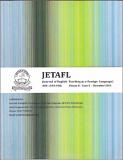Vocabulary of EFL Learners (Academic Year 2015) in Learning English at FKIP UHN Pematangsiantar
Abstract
This research discusses the vocabulary adequacy of the students in learning English at FKIP UHN.Conncerning to the background of the research, there are two questions raised in this research they are (1) How many vocabularies do university students typically have at Vocabulary class on semester III at FKIP UHN? And (2) What specific program or learning strategy should be given to increase vocabulary size to make the vocabulary class sucess? The objectives of the research are: (1) To find out how many the vocabulary an average students typically have at vocabulary class on semester III at FKIP UHN and (2) to find out some methods and techniques that are appropriate to increase vocabulary size to make the vocabulary class sucess. This research, the writer hope will bring some benefit to parties involved in the learning system. For the teachers, this is to help them turn around their objective or teaching to be more lexically, and not structurally oriented. For the authority in Education Ministry, of course this is allso a helpful means creating the national curiculum KKNI. Last but not least, for the ones interested in vocabulary learning research this study can be used as a stepping stone to carry out further research that enrich our knowledge on vocabulary. The theories used in this research are by many authors: (Carter, 2000), Nation (2001), Grabe and Stoller (1997). There are two subjects that the writer will analyze in this research. Firstly, the 1953 General Service List. The writer used FSL as one of the subject in this research to find out the content of it to find out the appropriate methods to teach those words in the list. Another research subject of the resarch is the students (academic year 2015) taking Vocabulary subject at English. the writer found several data from the list. The first one is the inclusion of related forms under a headword. If all related forms are considered the headword, the GSL consists of 2,000 items. But this is clearly not the case. To take an extreme example, these derived forms are listed under Effect: effectively, efficient, effetive, efficiently and affect. This entry for Effect does not represent a single learning unit for a student of English. Using the family word base, the GSL consists fewer than two thousand words. Secondly, reading transcription of the frequecny memebrs of the words is tedious task. Not many readers need the actual frequency number since they only concentrate on the rank order. Thirdly is the issue of whether the frequency numbers of related forms should always be added to the headwords before the words are related. If not, in which cases should the numbers be added? The last concern is related to the age of the written material that the frequency numbers come from.

